How to create PowerPoint templates that work
Without a proper PowerPoint template, presentations can be a bit of a mess. Here are the building blocks for developing a PowerPoint template that works!

Zoom in PowerPoint is a terrific tool that allows you to jump straight to the content you want and supports a seamless interactive presentation. It’s really quick and straightforward to do, but before getting into how PowerPoint Zoom links work, it’s worth showing you how to set up a presentation to make it easy to use them.
Keep reading for written instructions and even more detail.
This is a fairly typical presentation with a whole lot of slides, but in slide sorter view, there’s a huge grey space over on the right-hand side where there are no slides.
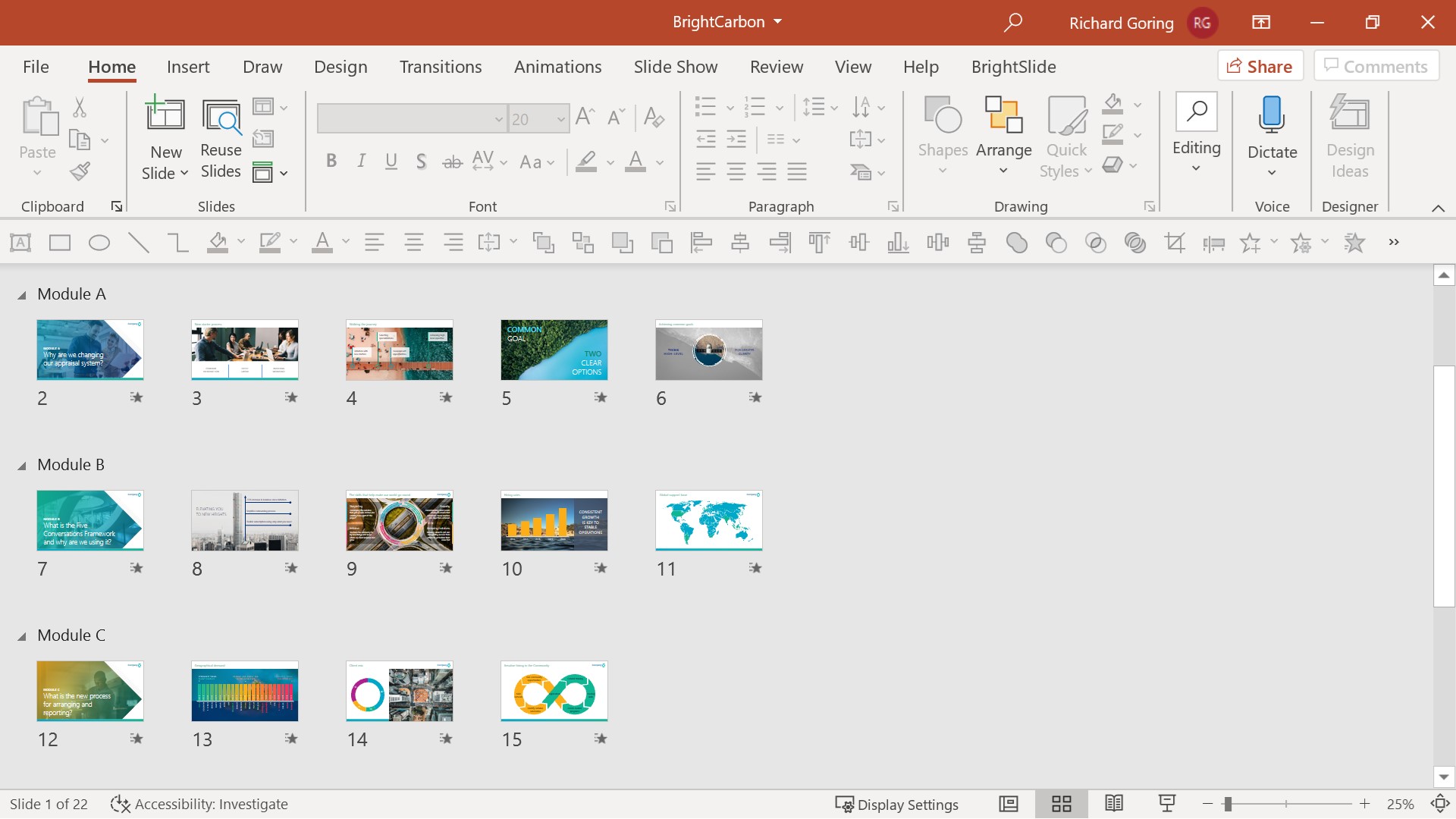
That’s because all the slides have been grouped into different sections, or in this case modules A, B, C, and so on. Why is that useful? Well, PowerPoint sections are a great way to categorize slides and organize your presentation. You can move sections around more easily, collapse all the slides to see an overview of the flow, and, perhaps mostly usefully, use sections to navigate.
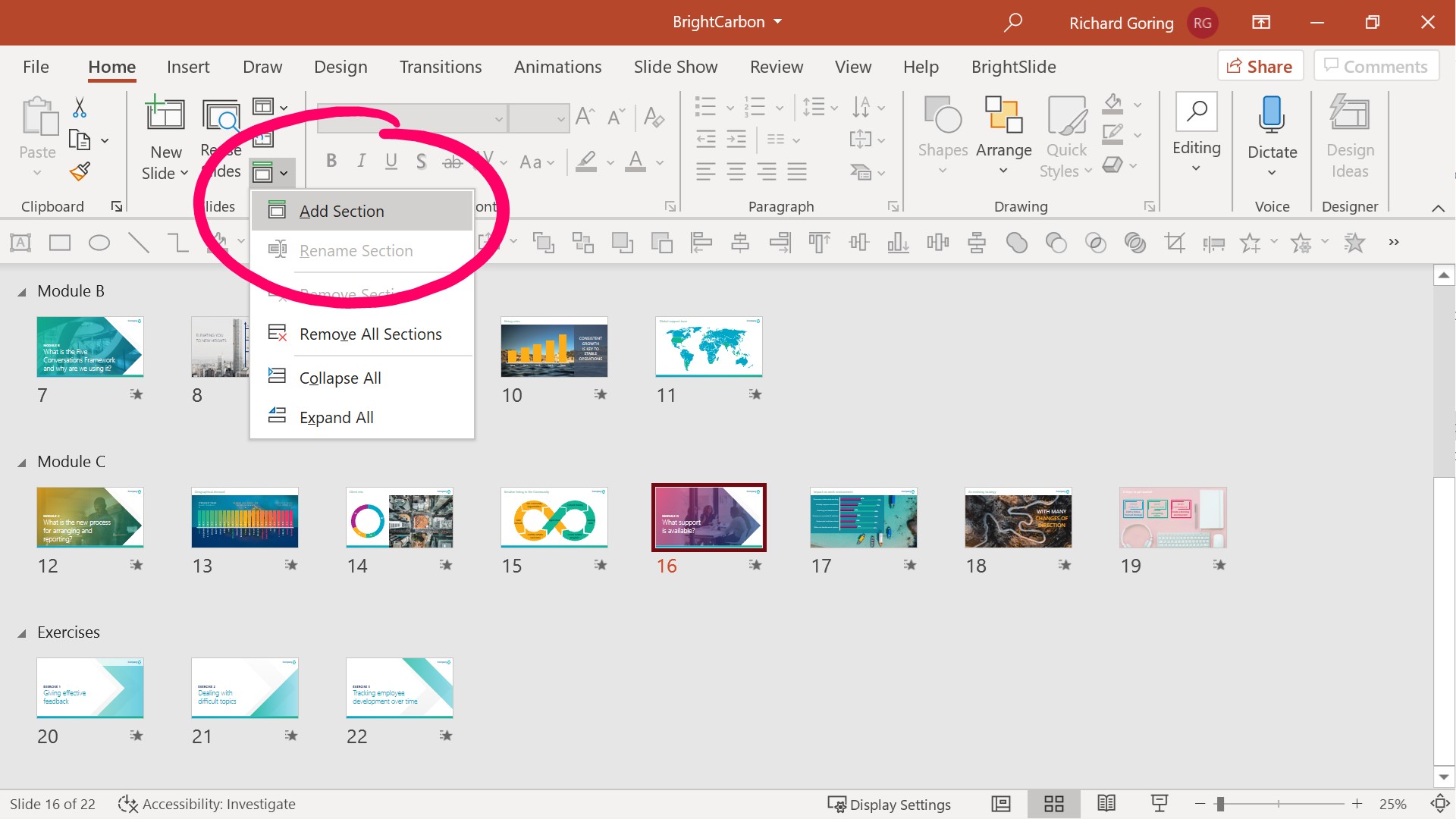
To add a section is very simple:
Once you’ve got sections in your presentation, you can start to navigate those sections using the PowerPoint Zoom link tool:
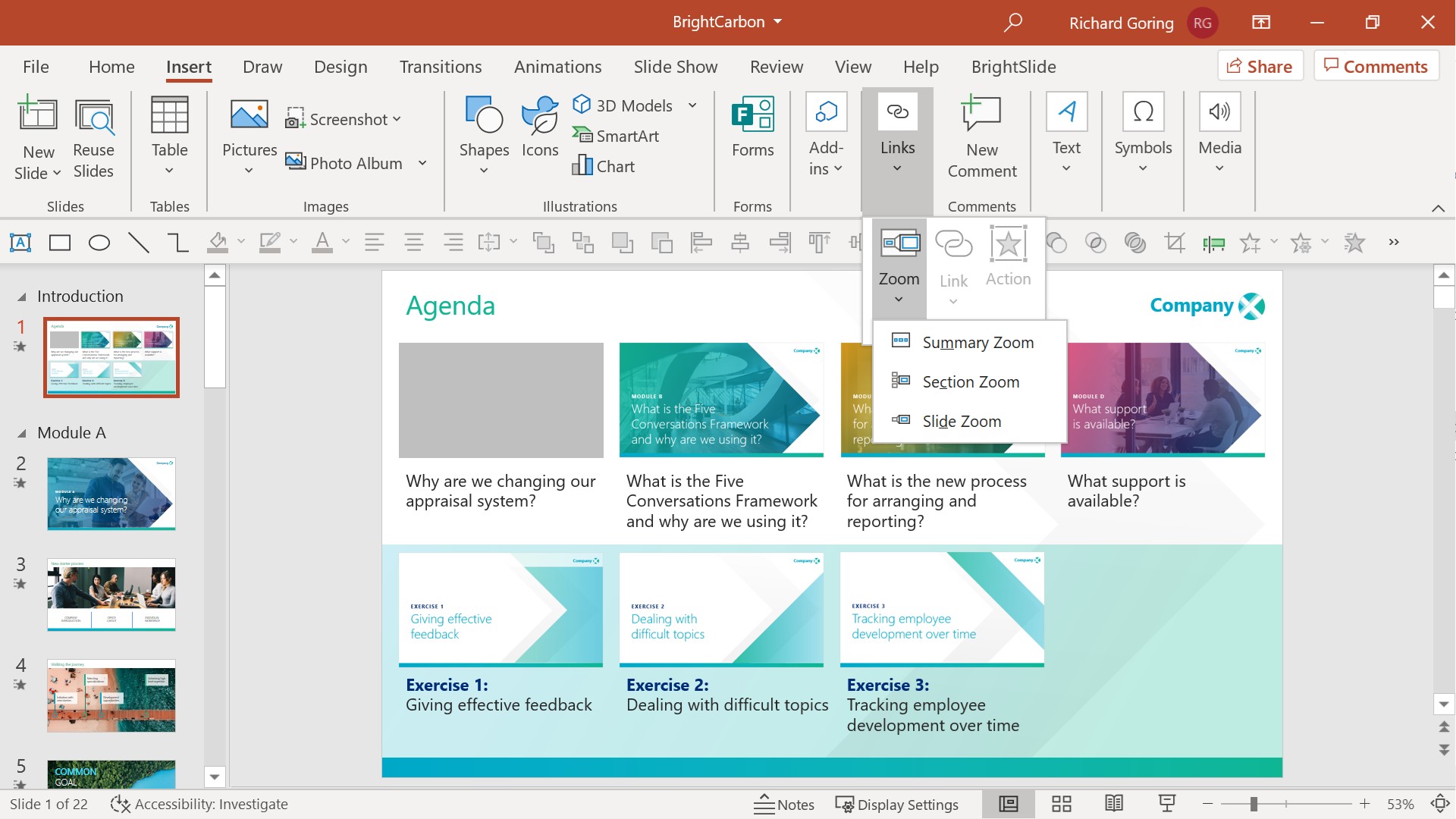
Top tip: Alternatively, drag a slide or a section header from the slide thumbnails view on the left to a slide in the main edit area, and it will automatically create a Slide or Section Zoom for you.
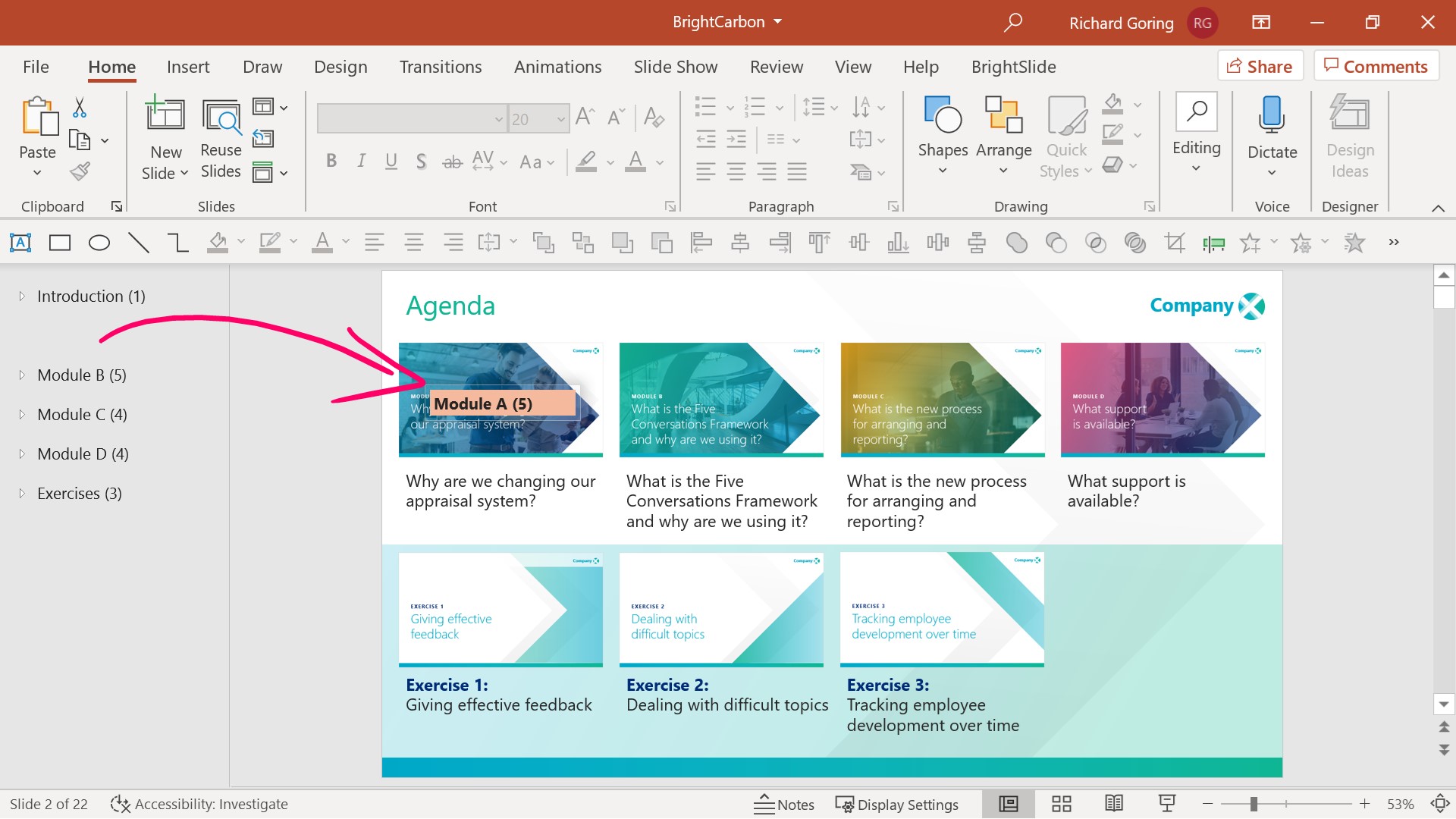
PowerPoint Section Zooms are perhaps the most interesting and useful. Choosing Section Zoom will bring up a list of all the different sections in your presentation. You can choose any of them and, once you click Insert, you get what looks like a thumbnail picture of the first slide from each of the selected sections on the slide.
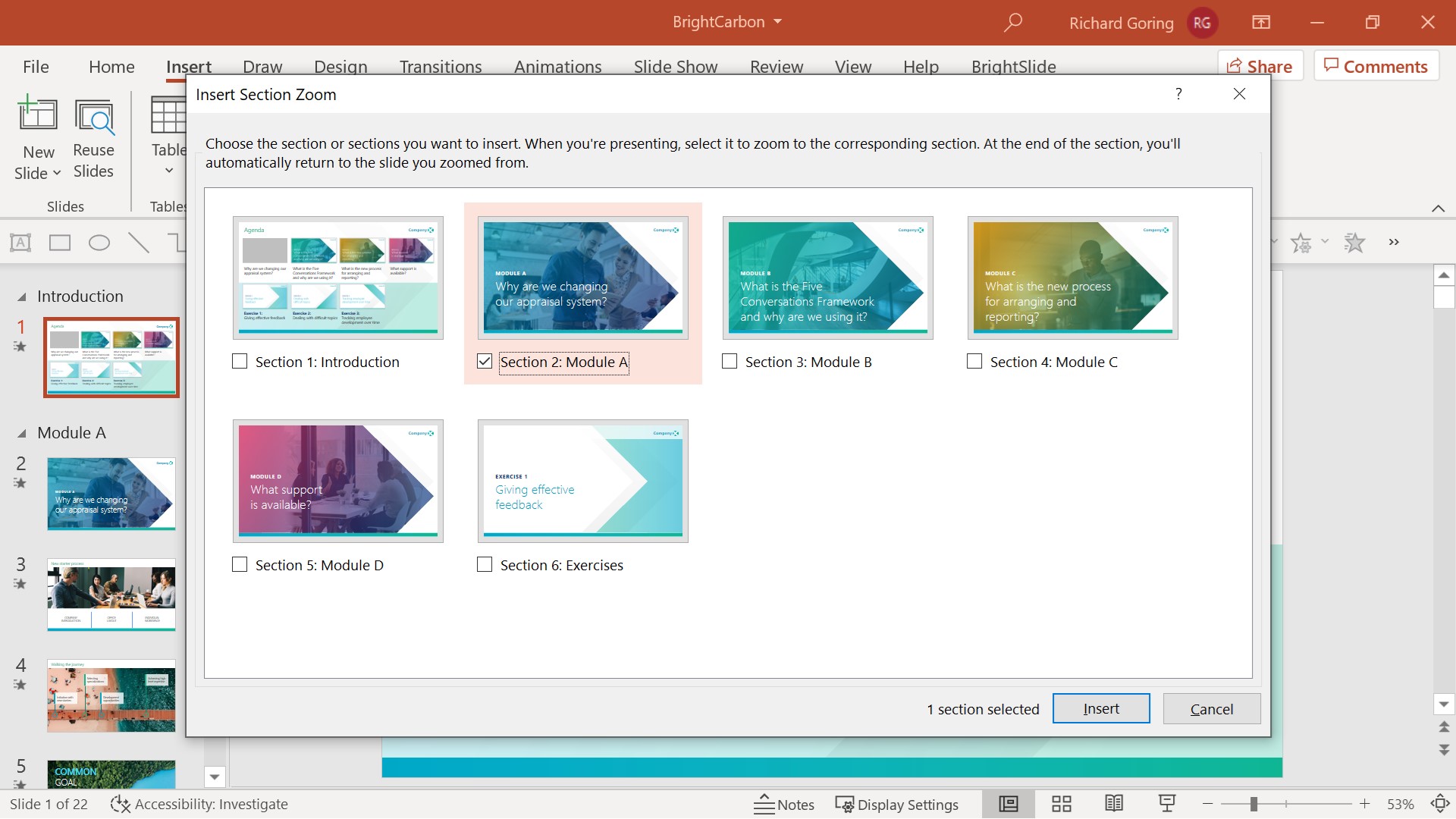
But it’s not actually a picture. It’s a clickable link that you can use to jump to that section in your presentation. And if you create several Section Zooms, for different sections of the presentation, you have a collection of thumbnail images that allow you to move through your deck in a non-linear way, either in response to an audience question, or because you know specific topics are more appropriate.
What’s particularly useful about Section Zooms is that when you click on a Section Zoom link in slide show mode, you zoom into the first slide in that section, then go through all the slides in the section as normal. However, when you get to the end of the section rather than moving onto the next slide in the deck, you are redirected back to the menu slide – or whatever slide had the Section Zoom link on it. This means that you’re immediately ready to go to a different topic, rather than being forced to follow the linear order of the slides.
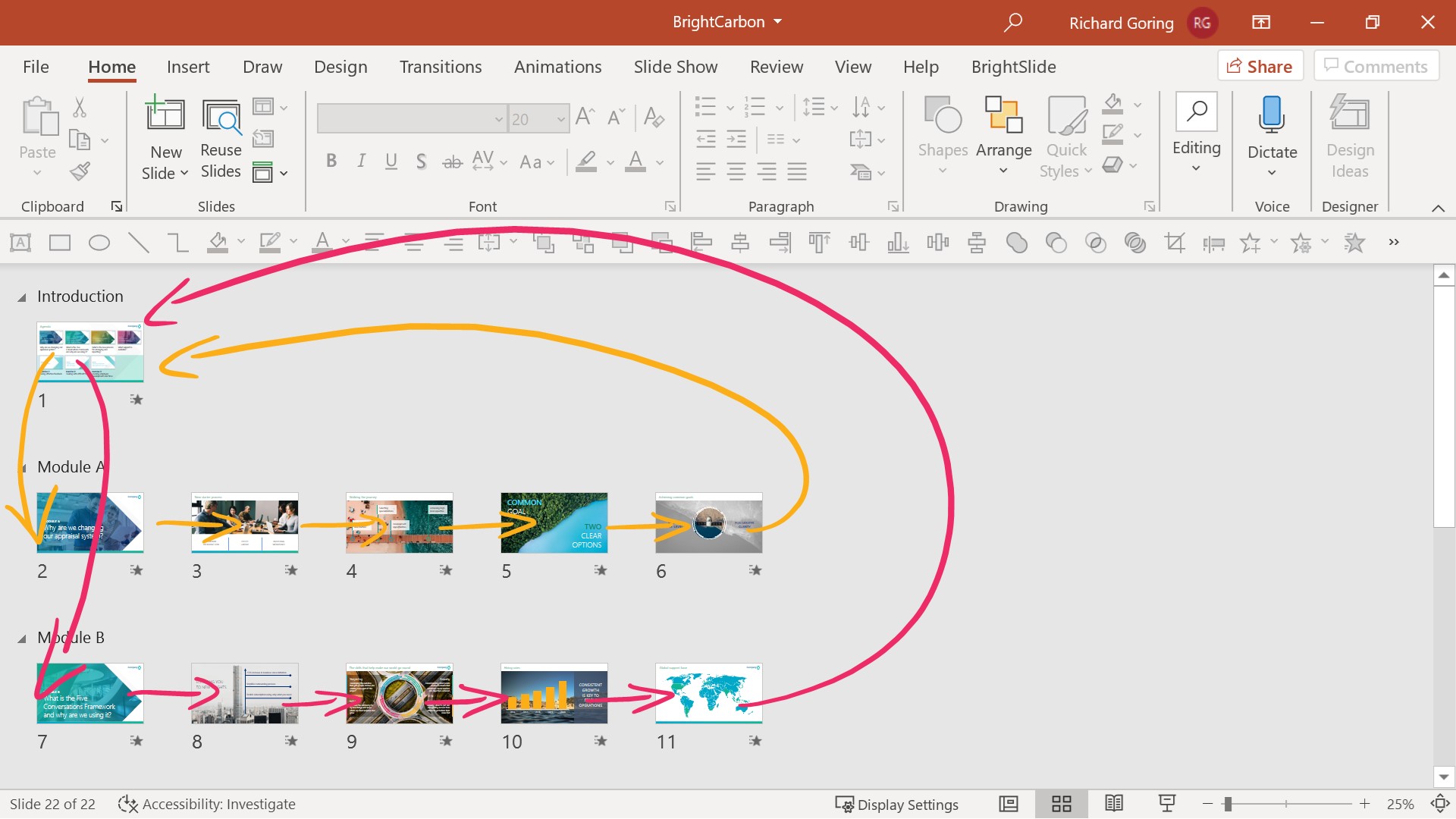
PowerPoint Slide Zooms are much simpler than Section Zooms, as they only link to a specific slide. This is great if you need to get straight to a supporting data slide in the appendix, or perhaps have several Slide Zooms that link to different case studies meaning you can always show something relevant to your audience.
A PowerPoint Summary Zoom is interesting because it automatically generates an overview of all the sections in your presentation as a set of Zoom links. But, unlike the Section Zoom function, you can choose what slide in your deck is the start of a section, so you don’t actually need to use the sections function. When you click on insert Summary Zoom, you’ll get a list of every slide in the deck, and any slide that you pick becomes the start of a Section Zoom, finishing with the slide before the next slide you pick. It sounds confusing, but is actually pretty simple when you try it. (It’s worth noting that any slide you choose during this process becomes the start of a new section, so be aware that new sections may be created this way).
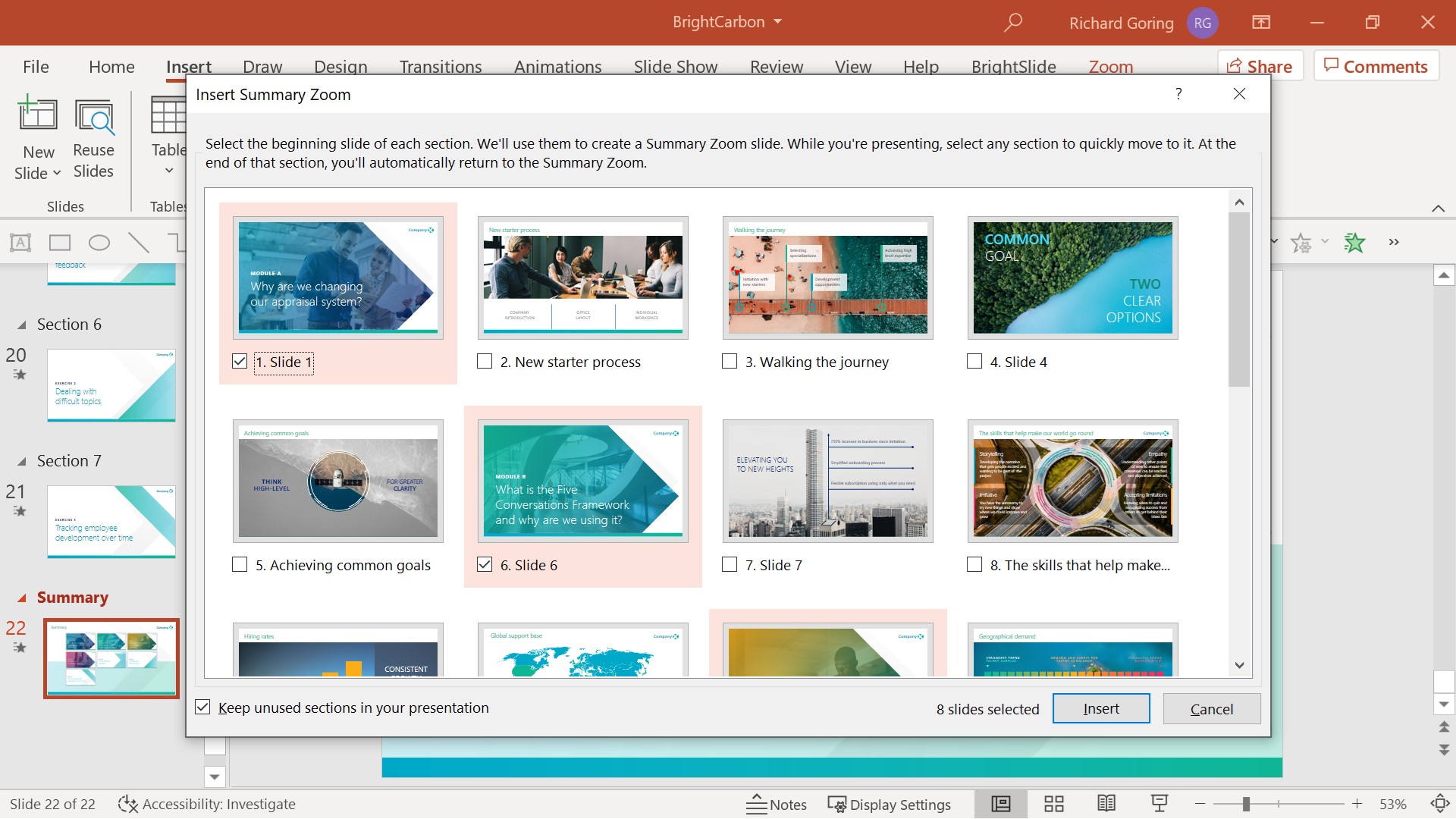
PowerPoint then automatically generates all the required Section Zooms in a grid for you, on a new slide at the start of the presentation, in a new section called Summary Section. The idea is that you use this new first slide as a launching point for your presentation, going straight to the content that’s most useful to your audience. Another good use is to move it to the end of your presentation as a way to get back to relevant content during a Q&A session.
Clicking on a Zoom link thumbnail will bring up the Zoom tab on the ribbon, which gives you control over a lot of the functionality. When you click on the tab, you’ll see that all of the Zoom link thumbnails on the slide get a small box with a number in. That shows you what slide (or sequence of slides with a Section Zoom) the link goes to. And a back arrow indicates that Return to Zoom is turned on.
On the tab itself, you have the same standard formatting options that are available for pictures, and on the left there are new options for controlling the Zoom in PowerPoint. The Return to Zoom check box means that once you’ve navigated to a slide or section (and gone through all of the slides), Zoom will bring you back to the slide with the original Zoom link on it (possibly a menu).
You can choose whether to use the Zoom Transition, which is really using the Morph transition to allow you to, well, zoom into the slide from the thumbnail. And you can choose how long this transition takes – whether it’s quick or (often painfully) slow.
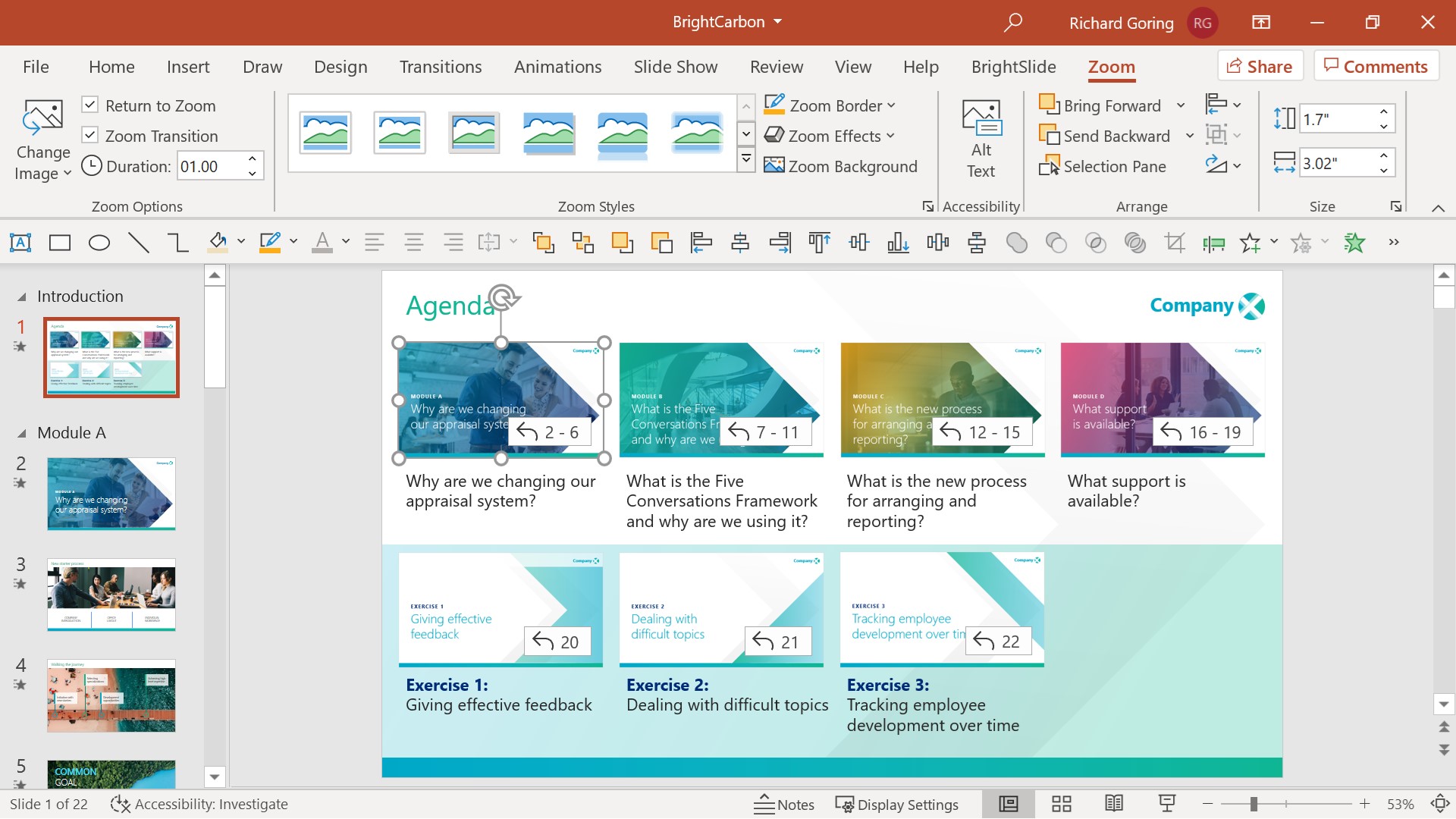
Return to Zoom is especially useful for creating navigable, non-linear presentations. You can do it with custom shows, or fiddly hyperlinks, but this just makes them so easy to create. Return to Zoom is enabled by default for Section Zooms, which make sense, but not for individual Slide Zooms. So, if you want to get back to where you started, you’ll need to select that option. A really good use case for using a PowerPoint Slide Zoom with a Return to Zoom is to link to appendix slides for more detail. Rather than forcing your audience to sit through a data table or source material, you can share the important conclusions, key messages, or trends, and then be ready with supporting information if they want to see it. You click the Zoom link, are taken to an appendix slide, then you click again and come straight back to the storytelling slide.
If you plan on doing that, then the Zoom transition itself is often more distracting than useful, so it may be best to turn it off. Likewise, having an actual thumbnail of the slide can get in the way, so you can change the Zoom link image on the Zoom tab, with the Change Image drop down. This allows you to alter the thumbnail to another image you have, or one of the stock images or stock icons built into PowerPoint. A simple icon to suggest more information might be easier to fit into your design than an image of the slide you’re going to.
If you have a PowerPoint Summary Zoom, then the Zoom link thumbnail grid is editable, allowing you to move each individual Section Zoom thumbnail around. But only within the confines of the Summary Zoom area. And, really frustratingly, you can’t use the alignment tools to rearrange the thumbnails. If you accidentally move something, there is a Reset Layout button on the left of the Zoom tab to take it back to the default layout. But otherwise, your best bet to get a new layout is to change the size and dimensions of the Summary Zoom area, using the white grab handles. With this method, the Zoom link thumbnails are always laid out in order, from left to right, top to bottom.
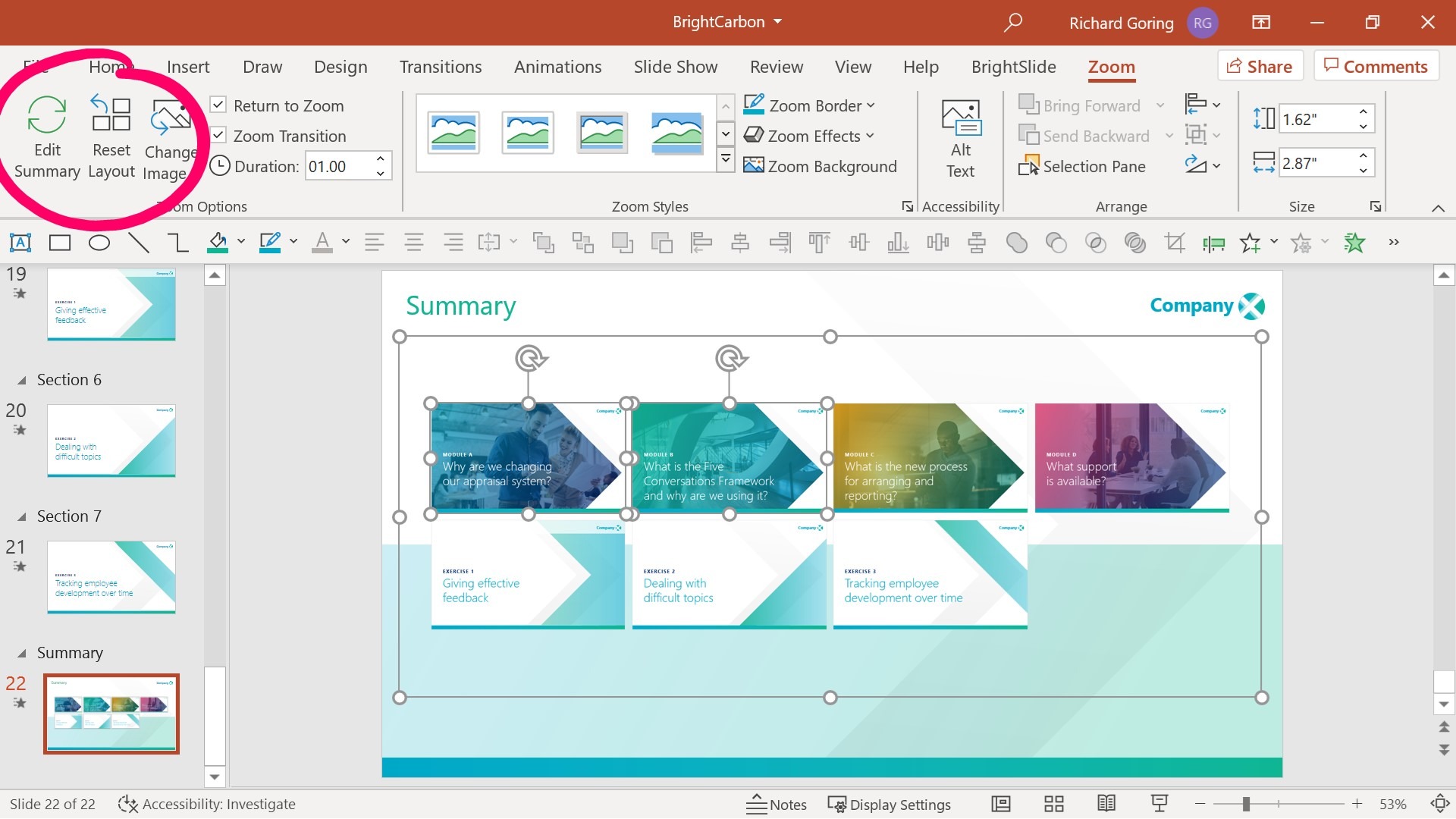
You can also use the Edit Summary button on the Zoom tab to remove any sections you don’t want included, or add in new sections that you’ve created, which is neat, as you can’t edit other types of PowerPoint Zoom link in this way.
Ultimately, PowerPoint Zoom links are a great way to create navigable presentations quickly and easily, allowing you to respond to your audience and have more interactive and engaging conversations.
If you’d like to create a Zoom navigation menu that doesn’t look like a gallery of slides, you can use the Zoom Background formatting effect to seamlessly blend the Zoom links into your slide. For example, this is a Zoom menu page with a set of Section Zooms on it, all with Zoom Background applied.
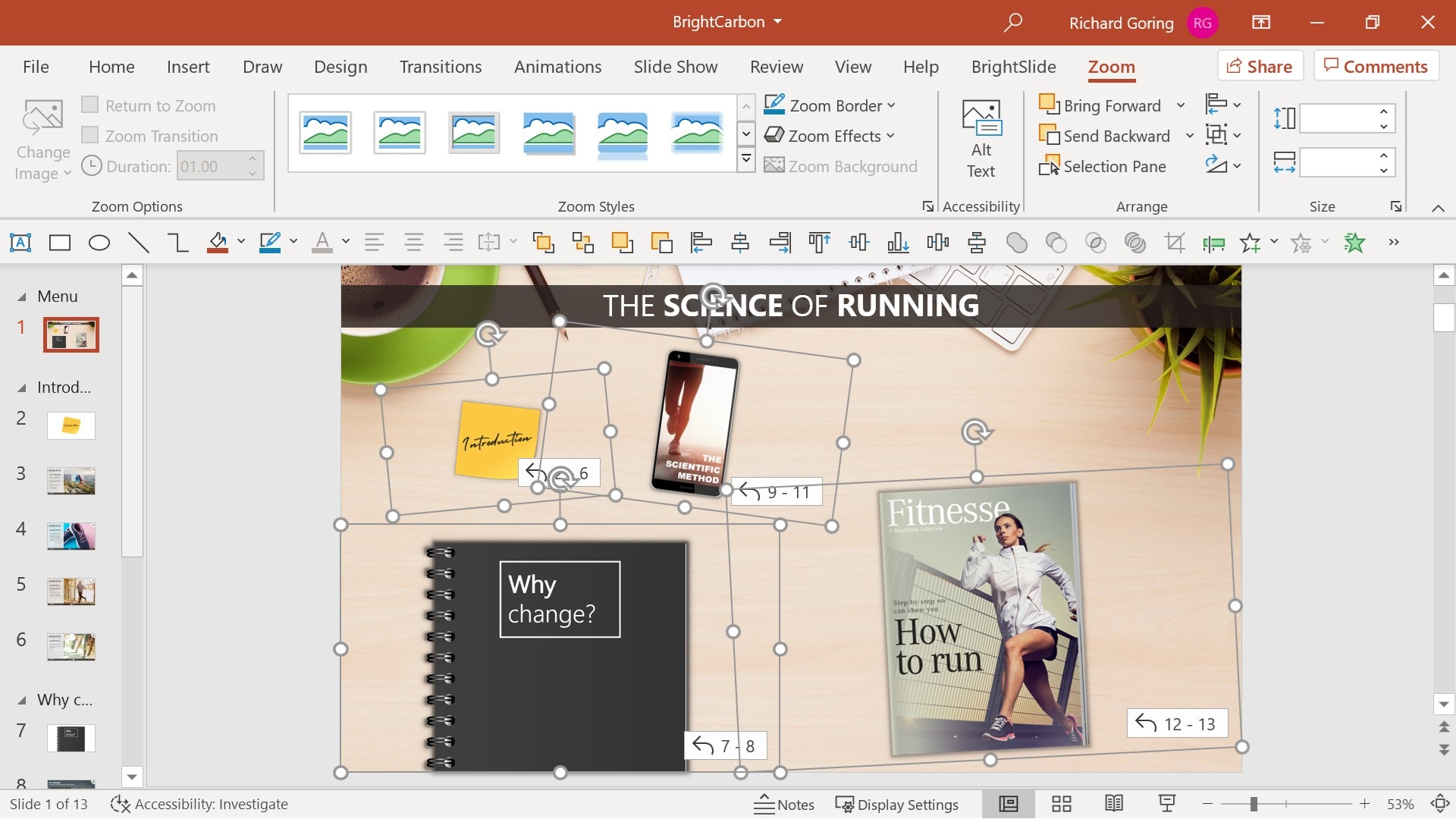
Zoom Background removes anything in the background or on the slide master of the target slides, showing you just the content of the slide in the Zoom link. To do it, click on the Zoom link, go to the Zoom tab on the ribbon, and then choose Zoom Background on the right, in the Zoom Styles area.
You can make it more natural still by making the Zoom links different sizes, or putting a (small) amount of rotation on them, or using the Zoom effects options (like shadow), or even 3D effects (sparingly), and the Zoom transition will morph seamlessly from one state to the next.
As good as this functionality is, there are a few issues with PowerPoint Zoom functionality that you should be aware of.
If you’re using Return to Zoom to get back to where you started, then you can’t mix it with hyperlinks. So, zooming to a slide or section and using hyperlinks to go somewhere else, and then coming back to the Zoom slide will mean that the Return to Zoom breaks and you’ll keep going in a linear fashion. In this example, the hyperlink navigation at the bottom of the slide breaks Return to Zoom. But we’ve used trigger animations for the main content (clicking the runner), which works fine.
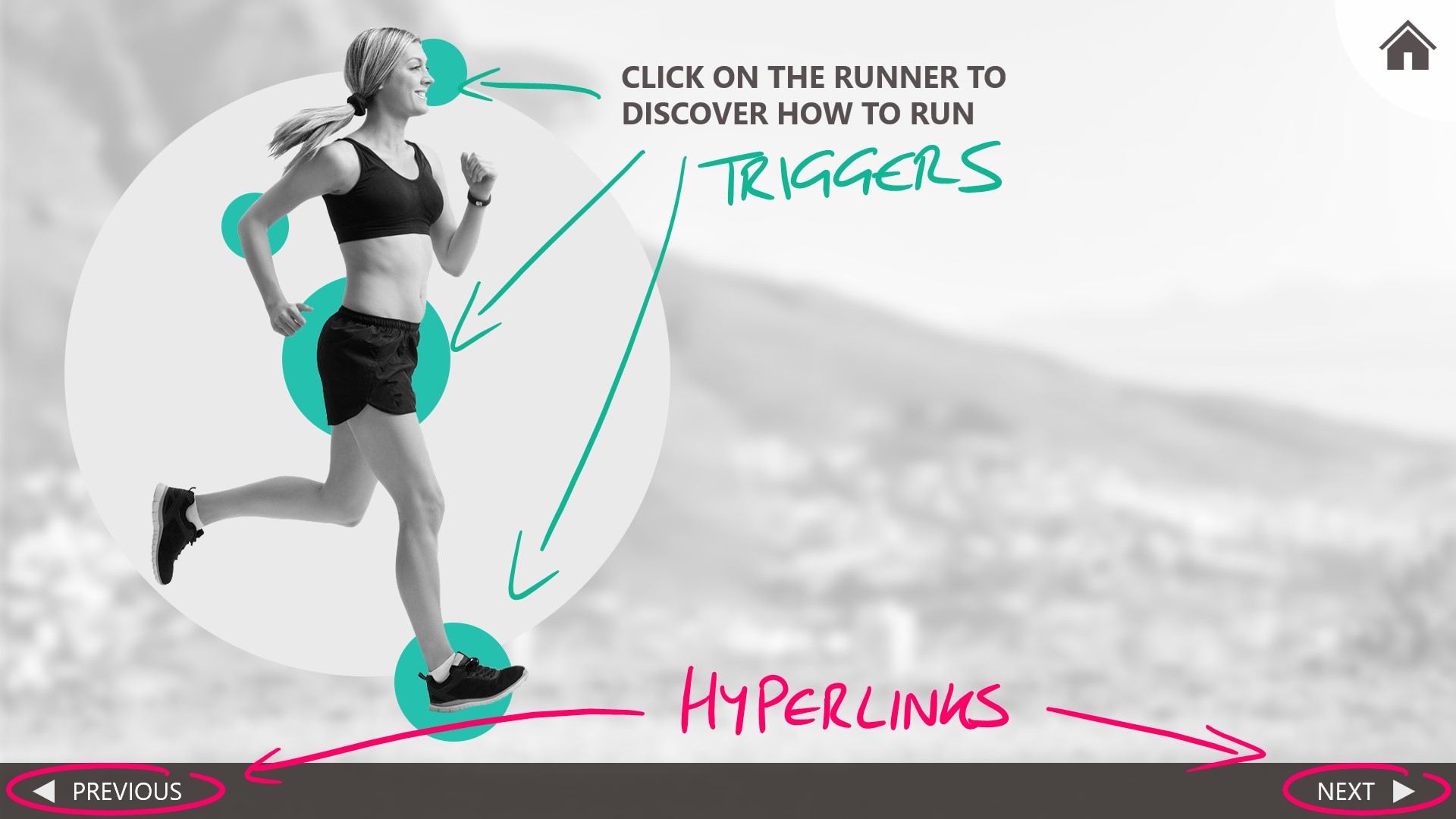
You can’t change the slide or section that a Zoom PowerPoint link links to once created, which is frustrating. So, if you have a Zoom link to go to slide 12 and you change your mind that it should be slide 14 instead, that won’t work. You’ll have to recreate it from scratch. But with the match size and position functions in our free BrightSlide add-in, it’s less annoying than it might be. And, to be fair, PowerPoint does everything it can to make sure that you don’t need to modify a Zoom link. All thumbnails of linked slides update automatically if the target slide changes. Copy pasting slides or sections into other presentations will preserve the Zoom link. If you copy a slide with a Zoom link into another presentation, but not the target slide, then the link will break. But, staggeringly, if you copy past the target slide into the same deck later on, in any position, the Zoom link will be restored. So you genuinely do have to go out of your way to break the links!
It’s also worth noting that this is really only for Office 365 or PowerPoint 2019. Earlier versions of PowerPoint will convert the Zoom links to hyperlinks, allowing you to move to the slide or section you want, but without the Zoom Transition, and the Return to Zoom function won’t work, so you’ll have to add in manual hyperlinks or a custom show to get back to the original slide.
Leave a commentWithout a proper PowerPoint template, presentations can be a bit of a mess. Here are the building blocks for developing a PowerPoint template that works!
By applying some key principles of presentation design, you can make your PowerPoint design really standout and deliver both a more ‘popping’, but also more effective presentation.
Most presentations are a cascade of text-heavy Death-by-PowerPoint slides. Online learners suffer the torture of brochures converted to click-through-eLearning. Most people now recognize that using visuals is the way to go. But how do you make visual presentations and eLearning that work? We think there are six steps you need to follow.
Join the BrightCarbon mailing list for monthly invites and resources
Tell me more!I absolutely love this, thank you so much. I have shared your fabulous resources with many folks. Thanks for all the brilliant work you do!
Michaela Butterworth State of Kansas

If the slide that you are zooming from is the last one in a section, it will make you go through every zoom before moving on to the first slide of the next section. Is there any way around that? There should be a way to choose what happens
Hi Carl. what I have done in the past is add a shape in an obvious location on the ‘launch’ slide so that when i need to move from it I can click on it to move to start of next section. I make this shape no outline / no fill so in effect it is invisible on screen but I know where it is (normally along the length or width of whole slide). Click on it when ready to move to the next section and carry on for rest of presentation. You need to create a final section of the remaining slides for zoom purposes. Hope it helps
I’m finding that when I copy/paste slide/sections that contain zoom links to anther deck then the links are breaking. You mention that shouldn’t be the case. Is there a specific way of doing it?
Very good article, thanks !! When displaying a Zoomed section (with say 5-10 slies) is there a way of dropping out of the zoom and back to the lauch slide ?? (pressing ESC is no good as it drops you out of the whole slideshow and back to authoring mode)
Thanks for the nice article! In the section “How to add a Powerpoint Zoom link” the image of a Zoom summary slide includes text under each of the slides (e.g., “Why are we changing our appraisal system”). This text is not on the target slide, but on the Zoom summary. Are these manually-added text boxes, or is there some automation involved to generate the text boxes?